Barriers to Open Access Publishing: Views from the Library Literature
Abstract
:1. Introduction
2. Previous Research
3. Data and Methods
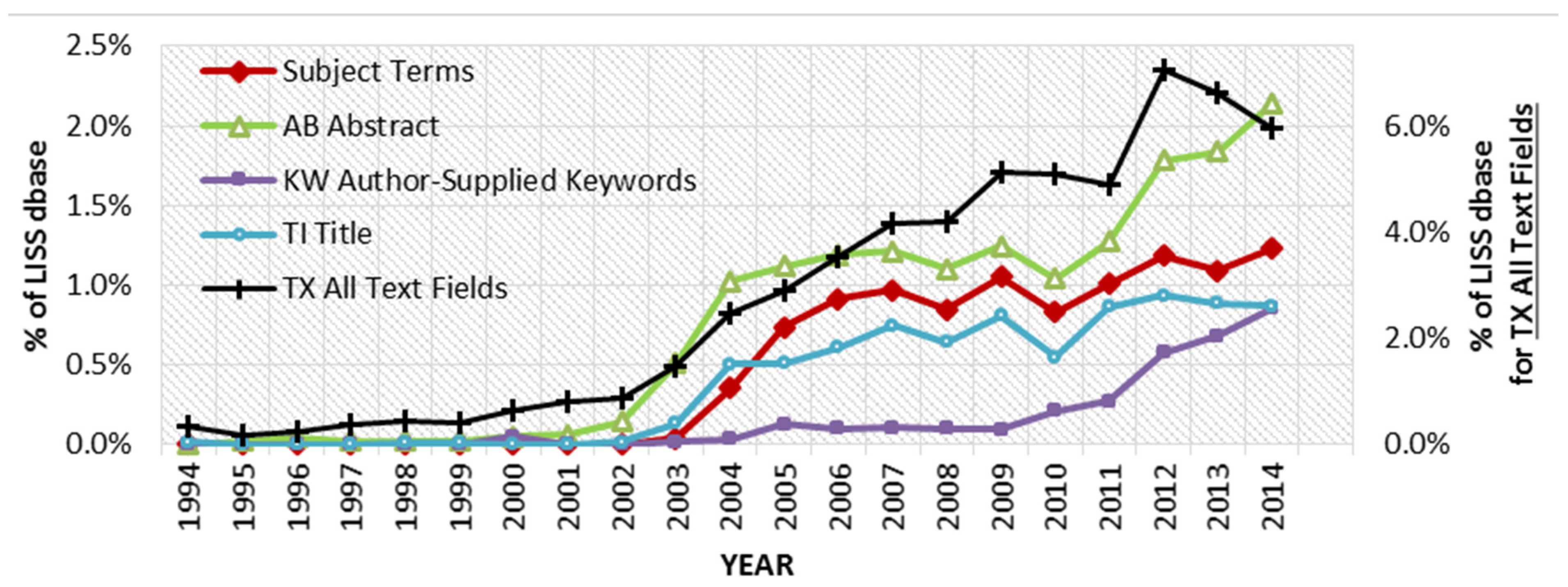
| YEAR | # Abstract |
|---|---|
| 2004 | 33 |
| 2006 | 108 |
| 2008 | 122 |
| 2010 | 120 |
| 2012 | 172 |
| 2014 | 154 |
| Total | 709 |
4. Results
4.1. Bibliometric Analysis
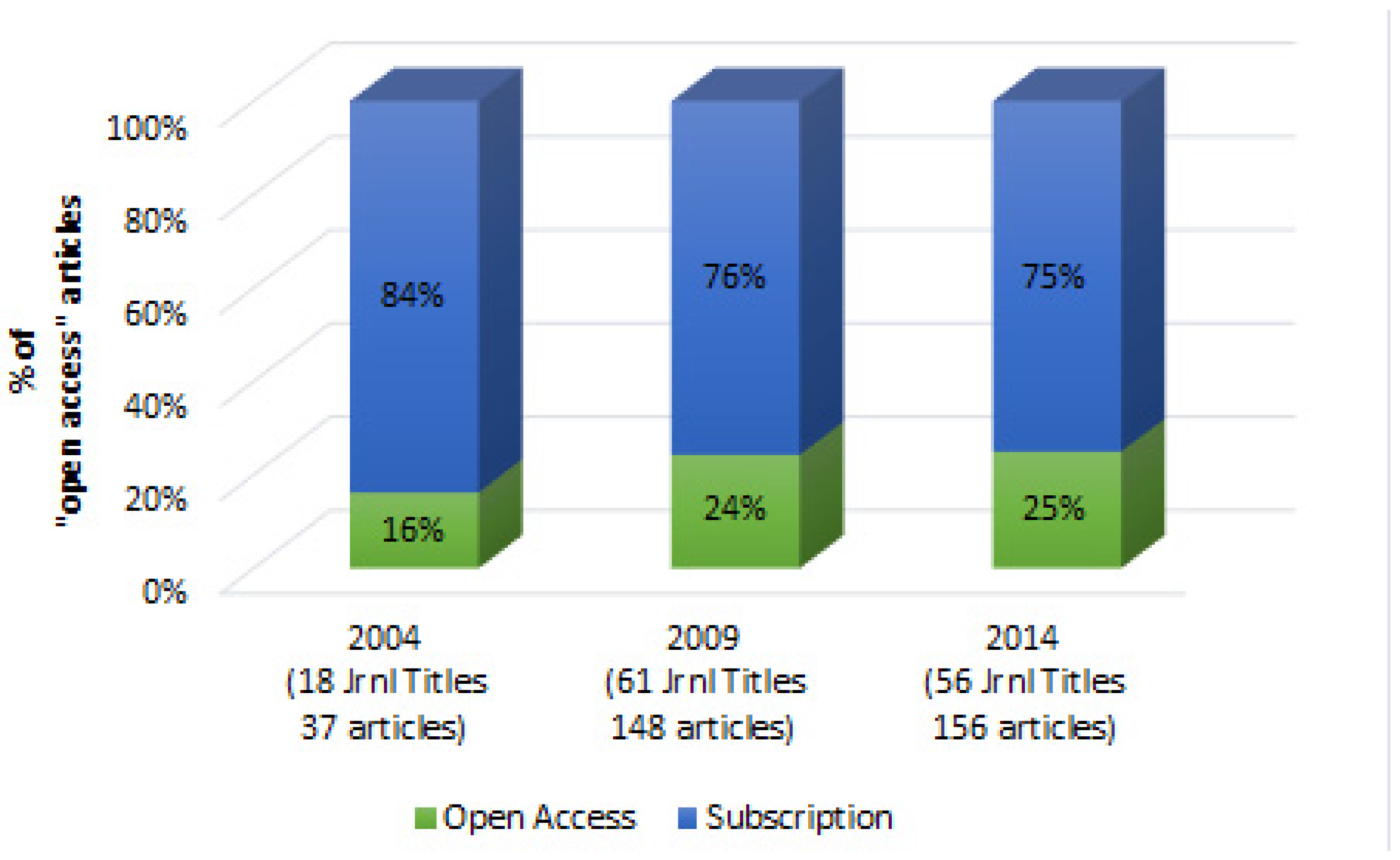
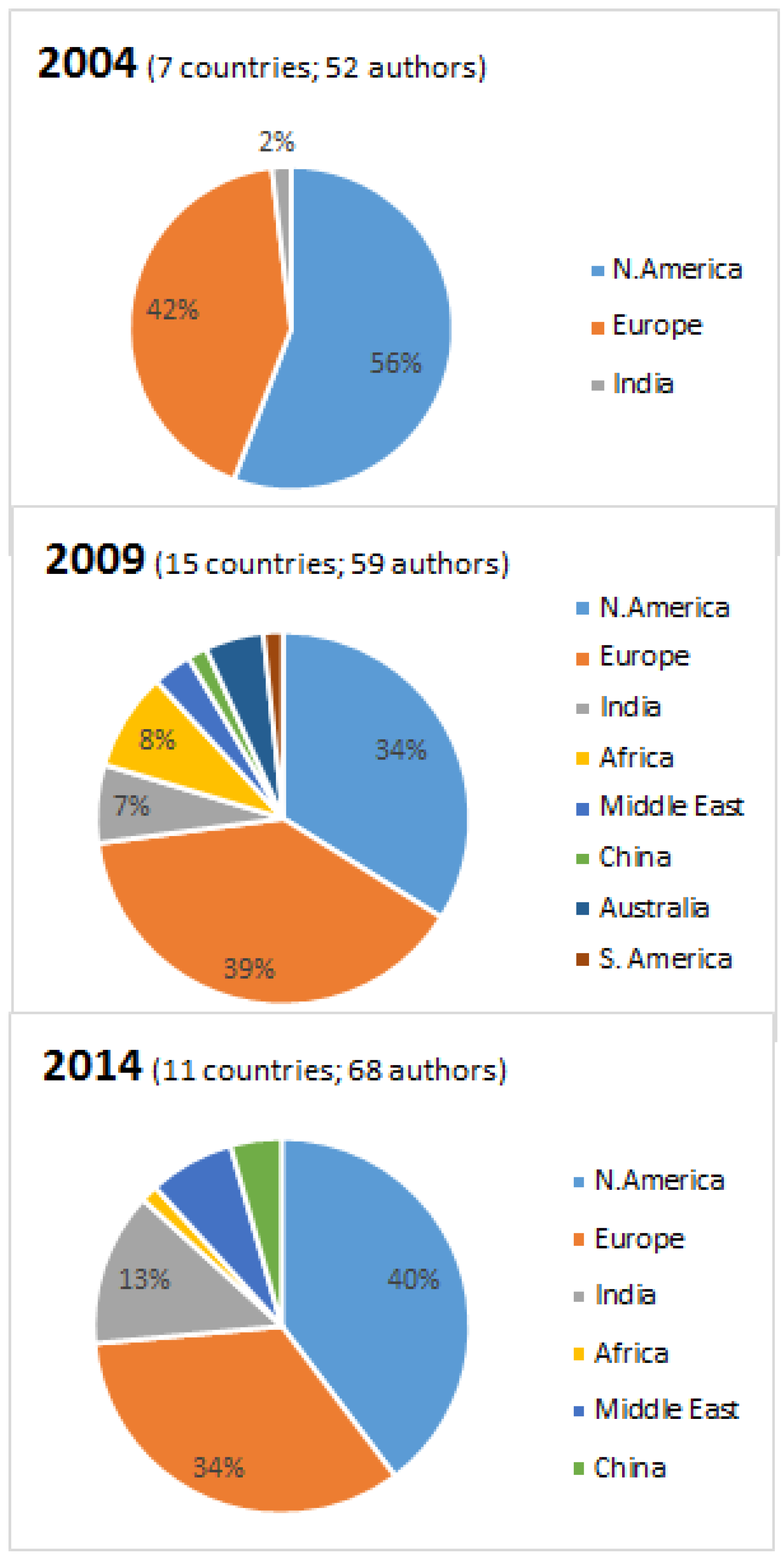
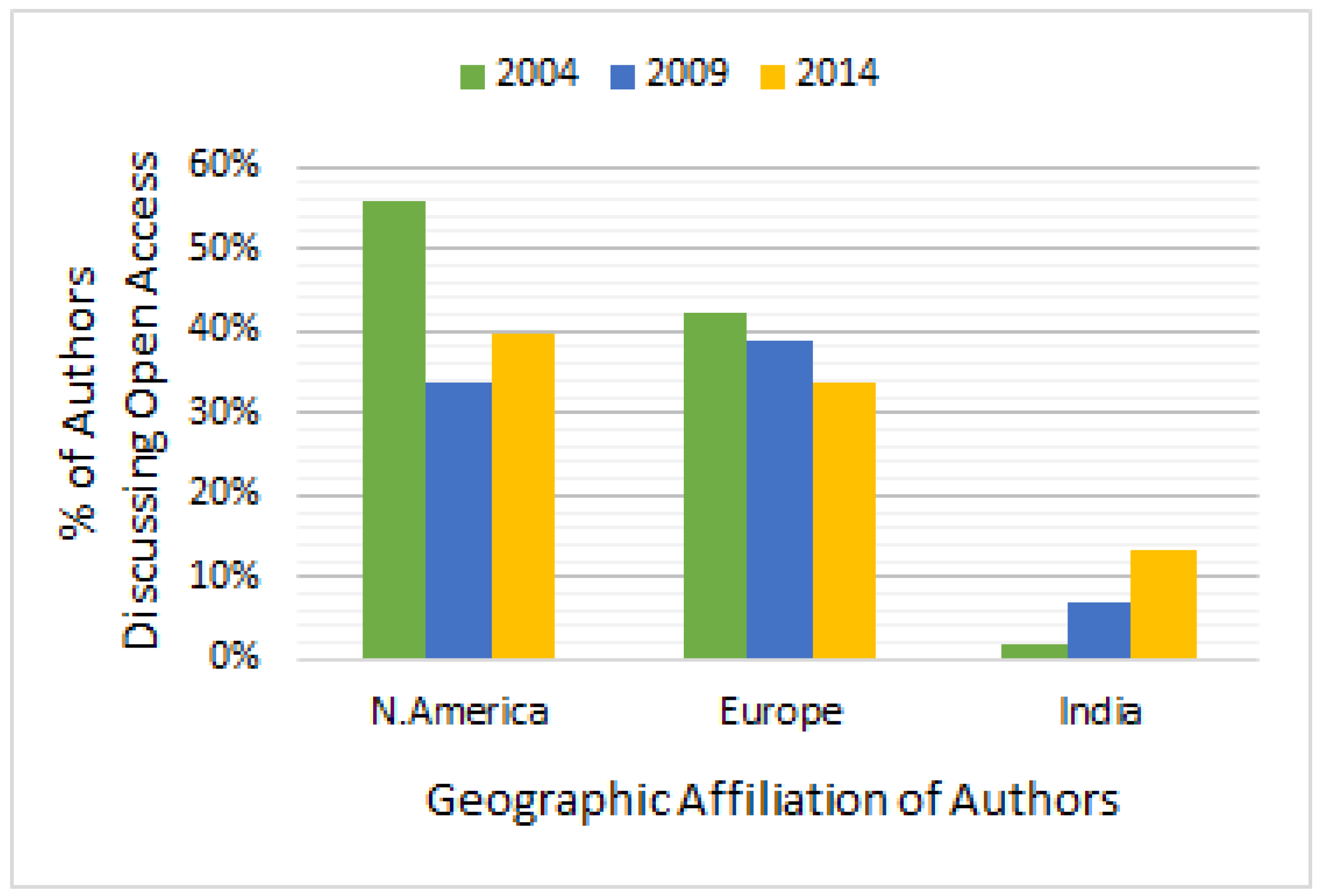
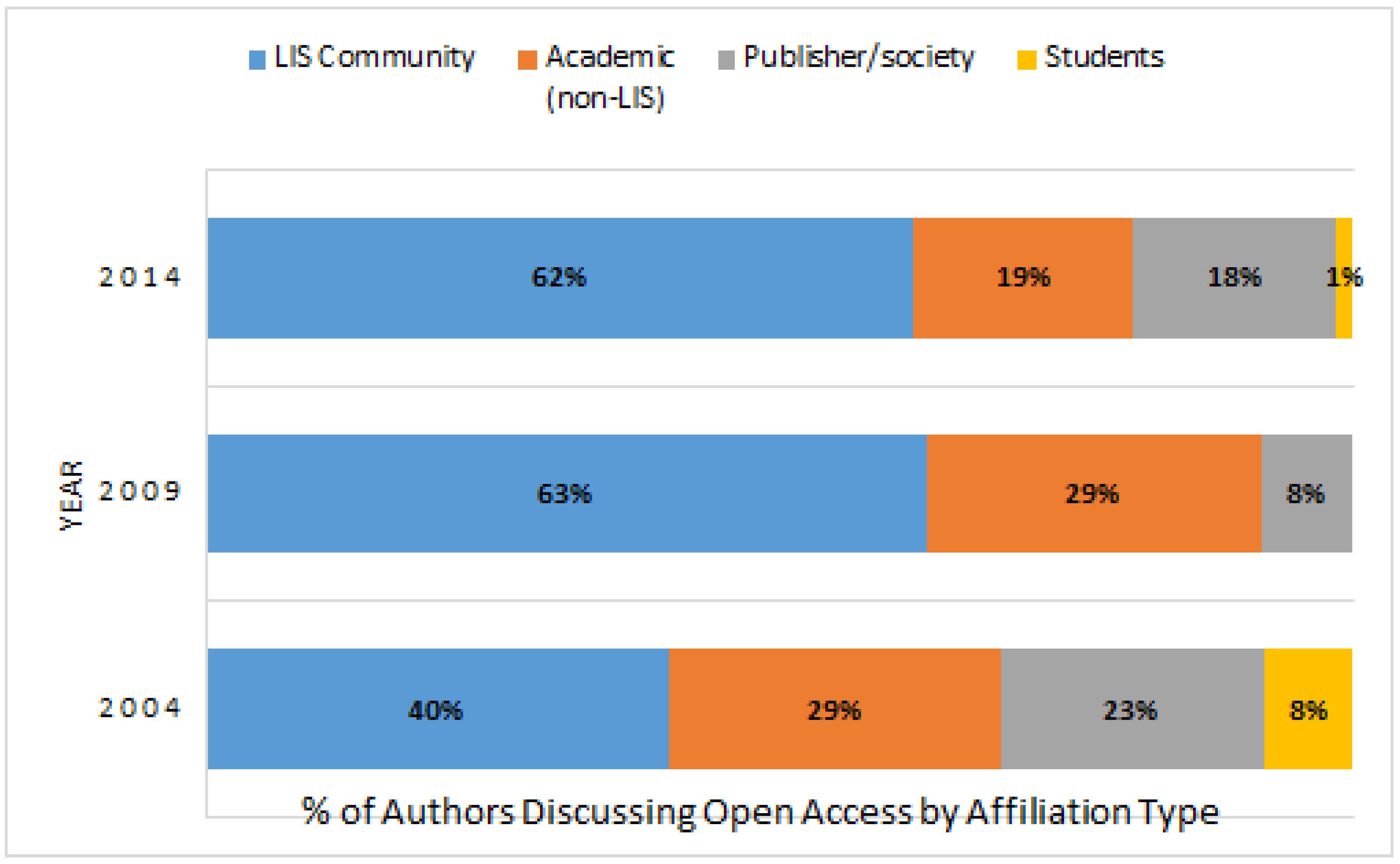
4.2. Content Analysis
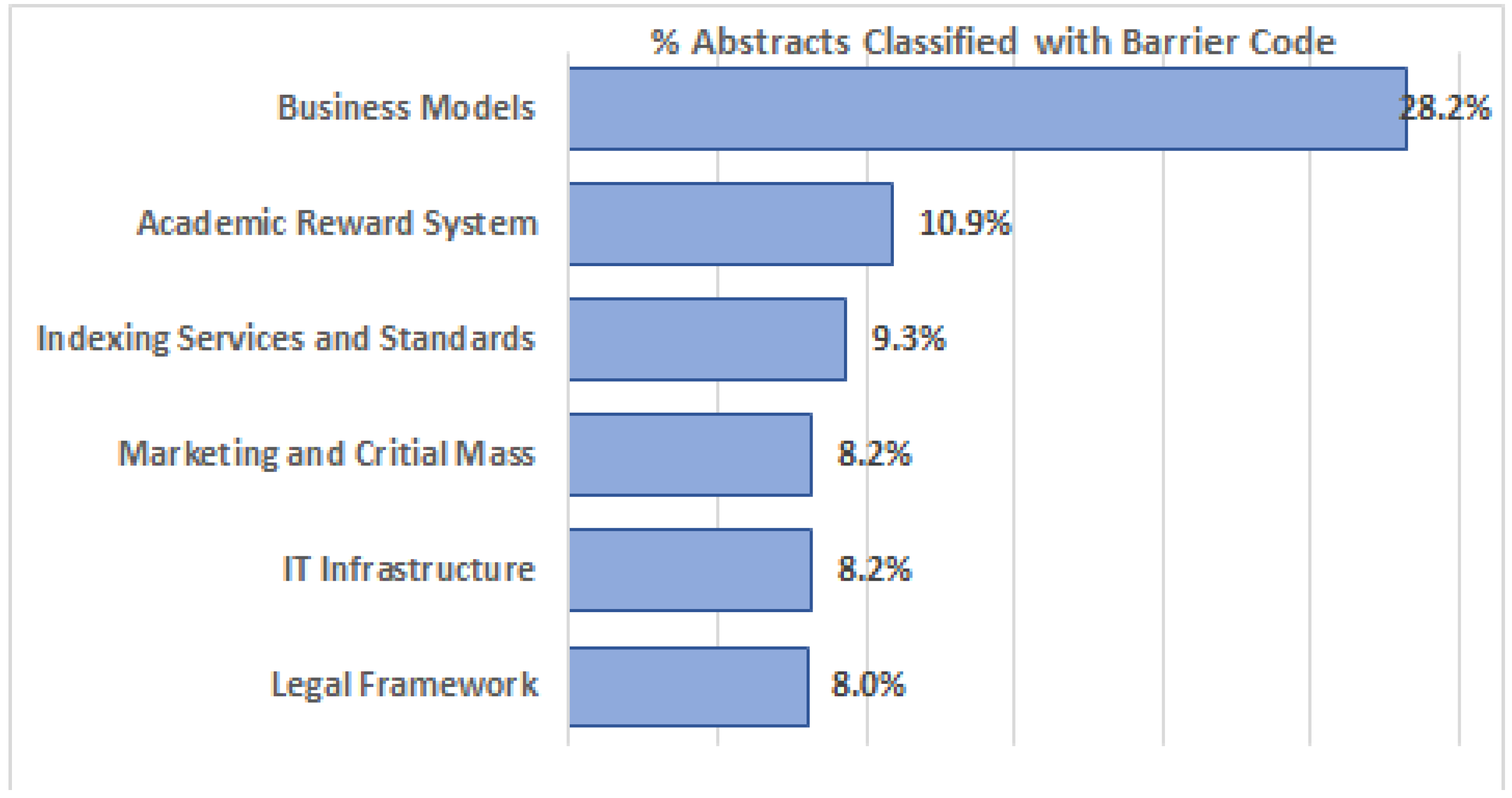
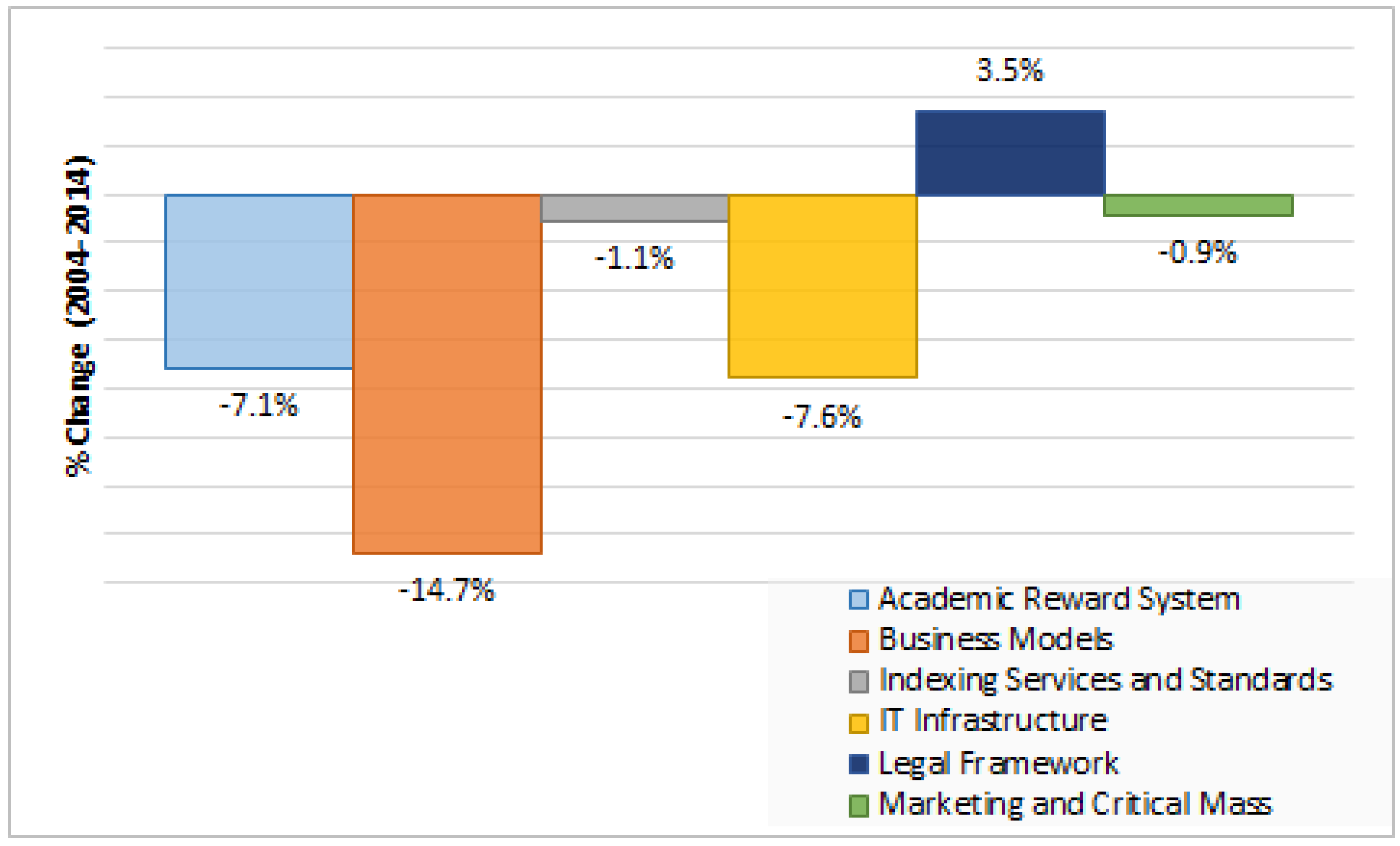
5. Discussion
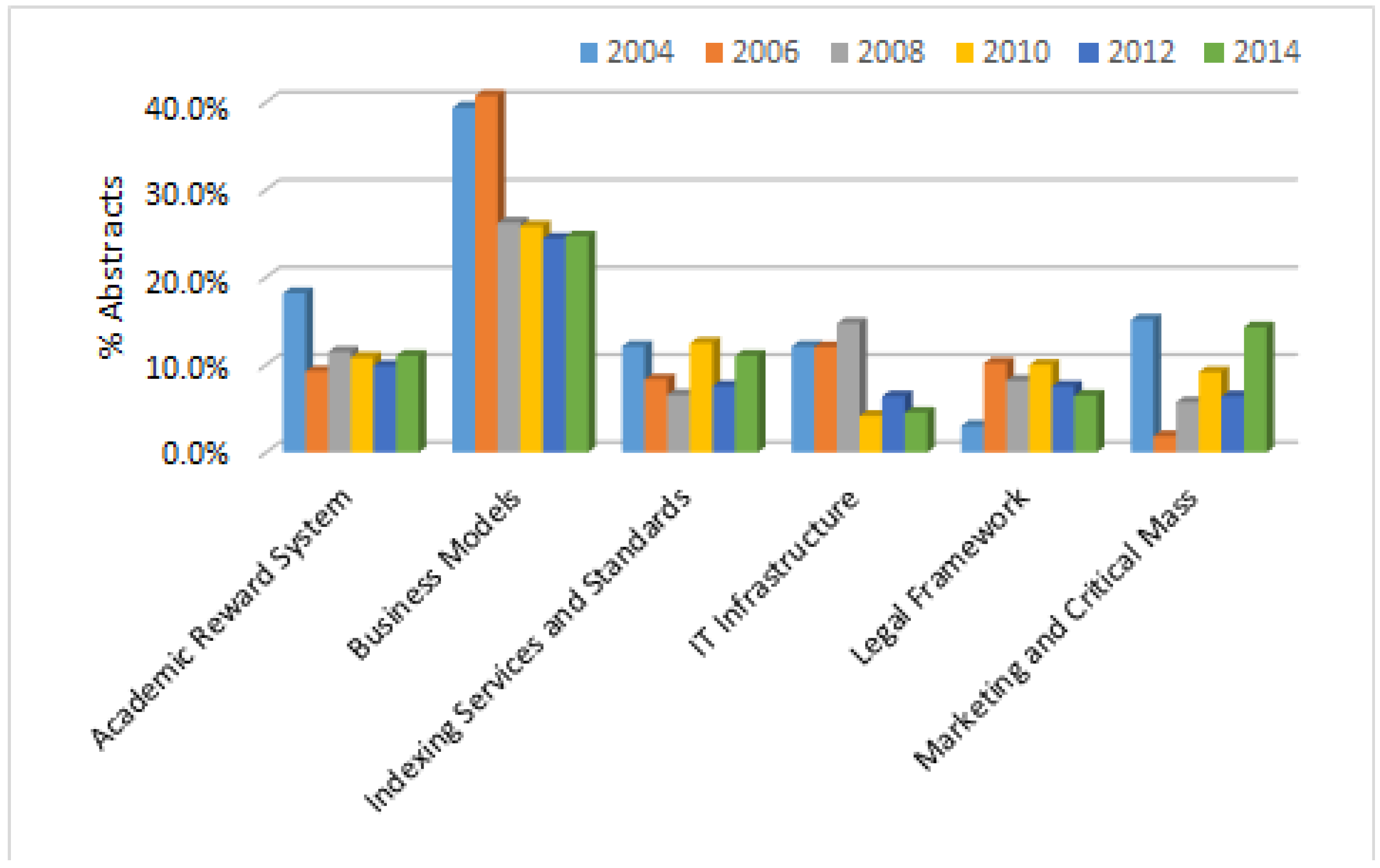
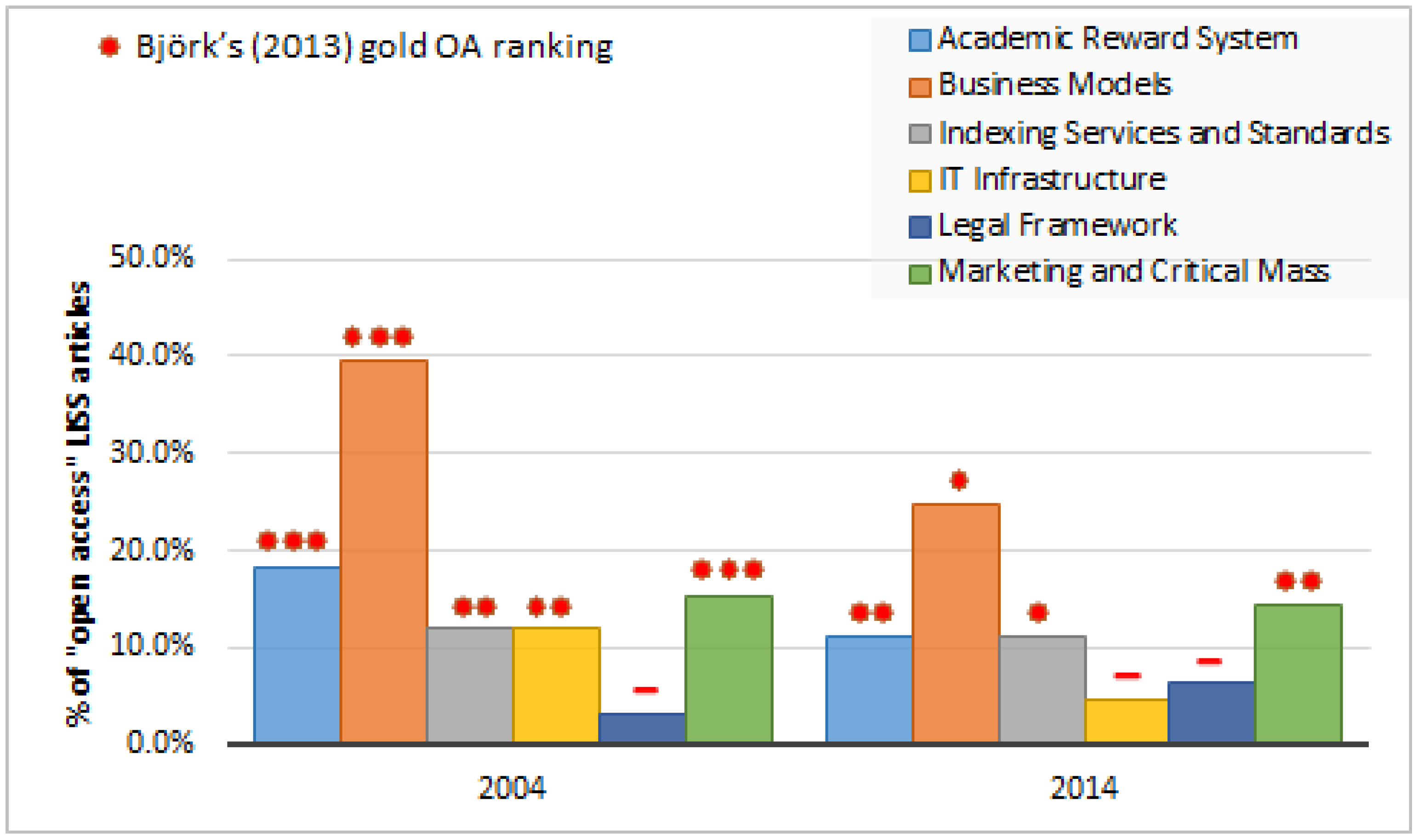
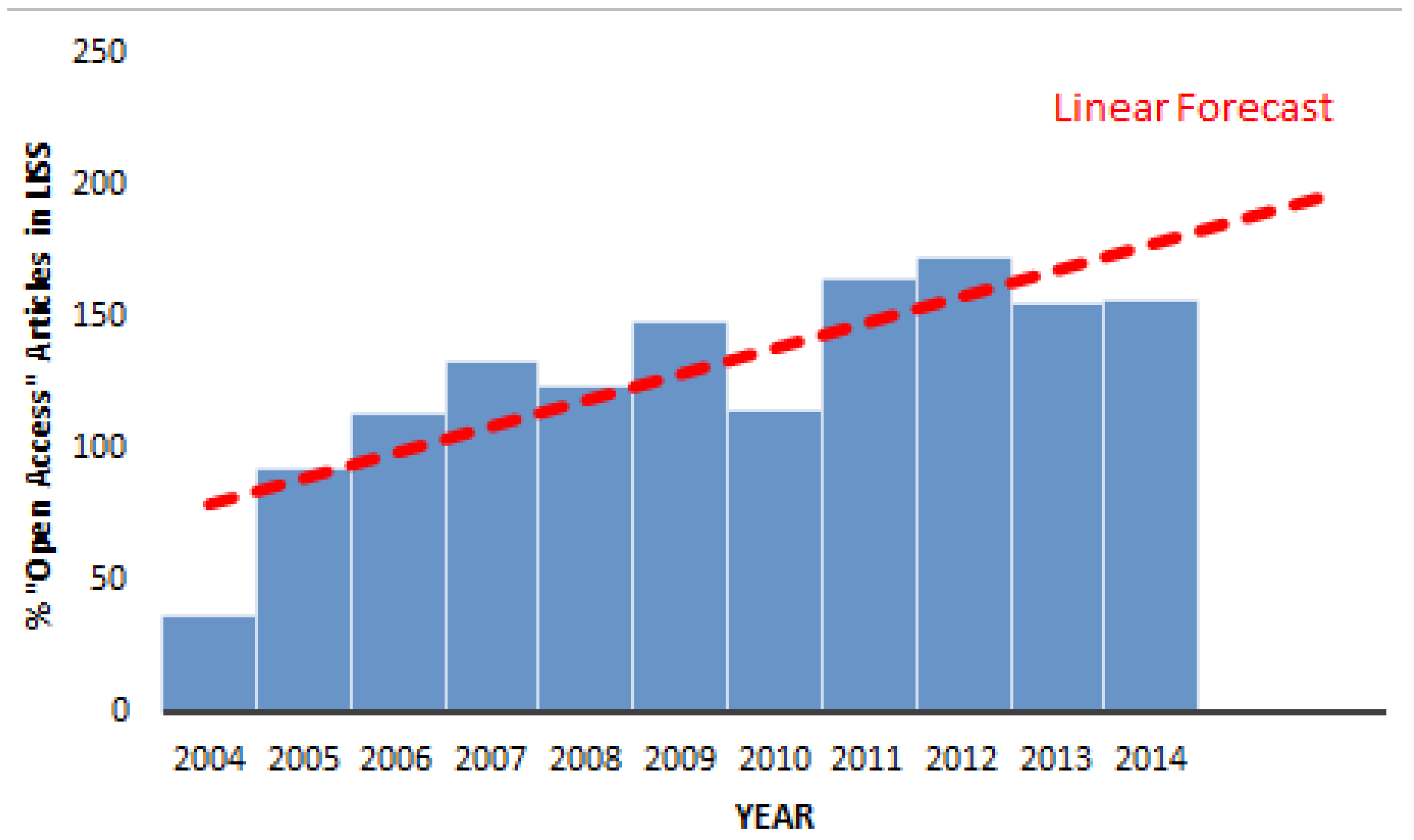
6. Final Remarks
Acknowledgments
Conflicts of Interest
Appendix
| Keyword | FREQ | NO. CASES | Keyword | FREQ | NO. CASES | Keyword | FREQ | NO. CASES | Keyword | FREQ | NO. CASES | Keyword | FREQ | NO. CASES |
|---|---|---|---|---|---|---|---|---|---|---|---|---|---|---|
| ACCESS | 1566 | 639 | WORK | 88 | 70 | INITIATIVE | 54 | 44 | SOCIETY | 41 | 31 | PROBLEMS | 31 | 25 |
| OPEN | 1476 | 635 | INCLUDING | 87 | 83 | BENEFITS | 52 | 43 | HUMANITIES | 40 | 30 | PRODUCTION | 31 | 20 |
| RESEARCH | 627 | 297 | PEER | 87 | 66 | ISSUE | 52 | 42 | 40 | 35 | SUPPLY | 31 | 13 | |
| JOURNALS | 588 | 241 | WORLD | 87 | 70 | SEARCH | 52 | 31 | SIGNIFICANT | 40 | 36 | AWARENESS | 30 | 25 |
| OA | 511 | 149 | BUSINESS | 85 | 55 | SERVICE | 52 | 31 | VISIBILITY | 40 | 30 | CENT | 30 | 10 |
| PUBLISHING | 487 | 270 | FREE | 85 | 68 | COMMERCIAL | 51 | 41 | DISCIPLINES | 39 | 30 | COMMUNICATIONS | 30 | 19 |
| ARTICLE | 429 | 345 | DESIGN | 84 | 82 | STATUS | 51 | 32 | RECENT | 39 | 36 | DISSERTATIONS | 30 | 16 |
| INFORMATION | 413 | 252 | COMMUNITY | 83 | 69 | CHALLENGES | 50 | 43 | LAW | 38 | 24 | EDITORS | 30 | 23 |
| SCHOLARLY | 341 | 213 | PROVIDE | 83 | 72 | COSTS | 50 | 40 | SOFTWARE | 38 | 28 | LIBRARIAN | 30 | 21 |
| REPOSITORIES | 289 | 123 | SURVEY | 83 | 45 | FUNDED | 50 | 43 | TYPES | 38 | 27 | MEMBERS | 30 | 25 |
| JOURNAL | 265 | 159 | ARCHIVING | 81 | 45 | OFFERS | 50 | 48 | ACTIVITIES | 37 | 31 | PROGRAM | 30 | 17 |
| PAPER | 265 | 159 | RELATED | 81 | 69 | INDIA | 49 | 24 | AVAILABILITY | 37 | 27 | READERS | 30 | 27 |
| LIBRARY | 250 | 168 | INCLUDE | 80 | 73 | LEVEL | 49 | 42 | FOCUS | 37 | 34 | SCHOLAR | 30 | 20 |
| LIBRARIES | 237 | 154 | PROJECT | 77 | 46 | MAJOR | 49 | 44 | INTRODUCTION | 37 | 36 | ADVANTAGE | 29 | 14 |
| ARTICLES | 229 | 112 | SUPPORT | 77 | 63 | SYSTEMS | 49 | 39 | MAIN | 37 | 35 | CENTRAL | 29 | 25 |
| ACADEMIC | 226 | 137 | CURRENT | 76 | 65 | GROUP | 48 | 38 | OPPORTUNITIES | 37 | 34 | CITED | 29 | 19 |
| SCIENTIFIC | 222 | 120 | FUTURE | 76 | 66 | HEALTH | 48 | 30 | PRACTICES | 37 | 29 | CONSIDERED | 29 | 26 |
| STUDY | 212 | 132 | PRESENTED | 76 | 74 | DIRECTORY | 47 | 35 | BOOK | 36 | 25 | CONTEXT | 29 | 27 |
| UNIVERSITY | 209 | 135 | PRESENTS | 76 | 75 | FIELD | 47 | 39 | FREELY | 36 | 31 | EXAMINED | 29 | 29 |
| DIGITAL | 201 | 121 | UNIVERSITIES | 76 | 55 | FOCUSES | 47 | 47 | LEGAL | 36 | 23 | IMPORTANCE | 29 | 27 |
| INSTITUTIONAL | 187 | 113 | MAKE | 74 | 62 | FULL | 47 | 35 | PROVIDING | 36 | 36 | MEANS | 29 | 28 |
| PUBLISHERS | 184 | 120 | METHODOLOGY | 74 | 70 | GENERAL | 47 | 40 | SCIENTISTS | 36 | 25 | PARTICIPANTS | 29 | 13 |
| DATA | 180 | 89 | TOPICS | 74 | 70 | HIGH | 47 | 42 | DOCUMENTS | 35 | 20 | TERMS | 29 | 22 |
| AUTHORS | 178 | 120 | ANALYSIS | 73 | 50 | COST | 46 | 35 | FACTOR | 35 | 21 | ARCHIVE | 28 | 21 |
| SCIENCE | 168 | 110 | CITATIONS | 73 | 30 | MATERIALS | 46 | 29 | PART | 35 | 32 | CHANGE | 28 | 22 |
| RESEARCHERS | 162 | 96 | SOCIAL | 73 | 53 | MEDICAL | 46 | 31 | PROJECTS | 35 | 30 | COLLECTED | 28 | 23 |
| MODEL | 159 | 93 | SYSTEM | 73 | 59 | SHARING | 46 | 37 | RESOURCE | 35 | 32 | COMPARED | 28 | 21 |
| IMPACT | 158 | 102 | REPORTS | 71 | 69 | THESES | 46 | 21 | RIGHTS | 35 | 28 | GOVERNMENT | 28 | 19 |
| REPOSITORY | 151 | 84 | INITIATIVES | 70 | 53 | YEARS | 46 | 40 | SPECIFIC | 35 | 26 | METHODS | 28 | 27 |
| PUBLICATION | 149 | 99 | TECHNOLOGY | 70 | 57 | ARCHIVES | 45 | 37 | ACCESSIBLE | 34 | 28 | TITLES | 28 | 15 |
| COMMUNICATION | 146 | 108 | PAPERS | 69 | 36 | BOOKS | 45 | 34 | EXISTING | 34 | 31 | TRENDS | 28 | 22 |
| LIBRARIANS | 140 | 91 | MANAGEMENT | 68 | 51 | DESCRIBES | 45 | 44 | GROWING | 34 | 32 | ACCESSIBILITY | 27 | 20 |
| BASED | 139 | 115 | FUNDING | 67 | 47 | DOAJ | 45 | 26 | IDENTIFIED | 34 | 26 | BARRIERS | 27 | 24 |
| DISCUSSES | 138 | 129 | SCHOLARS | 67 | 47 | EDUCATION | 45 | 37 | INCLUDED | 34 | 24 | CREATION | 27 | 20 |
| LITERATURE | 138 | 80 | DISCUSSED | 66 | 62 | INCREASE | 45 | 37 | PRESERVATION | 34 | 24 | GREY | 27 | 8 |
| WEB | 137 | 84 | INTERNET | 66 | 58 | METADATA | 45 | 24 | PROVIDED | 34 | 33 | LACK | 27 | 24 |
| AUTHOR | 134 | 93 | ORIGINALITY | 66 | 66 | STUDENTS | 45 | 32 | STATE | 34 | 29 | NETWORK | 27 | 24 |
| PUBLISHED | 132 | 99 | POLICY | 66 | 48 | ENVIRONMENT | 44 | 40 | WAYS | 34 | 32 | PHYSICS | 27 | 21 |
| ELECTRONIC | 131 | 95 | ROLE | 66 | 54 | POLICIES | 44 | 35 | CASE | 33 | 32 | SELECTED | 27 | 23 |
| KNOWLEDGE | 127 | 84 | USERS | 66 | 49 | SUBSCRIPTION | 44 | 38 | COUNTRY | 33 | 24 | SET | 27 | 22 |
| ONLINE | 127 | 84 | COUNTRIES | 65 | 39 | DATABASES | 43 | 21 | FORM | 33 | 30 | SOURCES | 27 | 20 |
| CONTENT | 126 | 80 | QUALITY | 65 | 50 | FACTORS | 43 | 29 | HELD | 33 | 30 | USAGE | 27 | 18 |
| FINDINGS | 125 | 105 | COPYRIGHT | 62 | 45 | GLOBAL | 43 | 34 | INFRASTRUCTURE | 33 | 26 | USER | 27 | 22 |
| PUBLIC | 119 | 81 | NATIONAL | 60 | 46 | HIGHER | 43 | 36 | LIS | 33 | 14 | YEAR | 27 | 21 |
| FACULTY | 118 | 46 | TRADITIONAL | 60 | 48 | KEY | 43 | 40 | OUTPUT | 33 | 25 | ADOPTION | 26 | 20 |
| ISSUES | 117 | 89 | PUBLISHER | 59 | 46 | TECHNICAL | 43 | 36 | RATE | 33 | 23 | DIFFERENCES | 26 | 21 |
| APPROACH | 115 | 97 | PROCESS | 58 | 50 | TOOLS | 43 | 35 | AREAS | 32 | 26 | INFLUENCE | 26 | 21 |
| PURPOSE | 111 | 76 | 57 | 31 | DISCUSSION | 42 | 35 | COLLECTIONS | 32 | 22 | MATERIAL | 26 | 21 | |
| INSTITUTIONS | 108 | 76 | IMPLICATIONS | 57 | 44 | DISSEMINATION | 42 | 37 | EXAMINES | 32 | 30 | PROFESSIONAL | 26 | 19 |
| DEVELOPMENT | 107 | 91 | IMPORTANT | 57 | 52 | REPORT | 42 | 34 | GROWTH | 32 | 30 | REGARD | 26 | 19 |
| MOVEMENT | 106 | 80 | PUBLISH | 57 | 45 | SCHOLARSHIP | 42 | 35 | INCREASING | 32 | 29 | SAMPLE | 26 | 17 |
| PUBLICATIONS | 104 | 79 | SUBJECT | 57 | 41 | UK | 42 | 34 | MAKING | 32 | 28 | AMERICAN | 25 | 18 |
| RESOURCES | 103 | 75 | DEVELOPING | 56 | 38 | AIMS | 41 | 38 | PRESS | 32 | 21 | GOLD | 25 | 16 |
| RESULTS | 100 | 82 | INTERNATIONAL | 56 | 47 | COLLECTION | 41 | 26 | STUDIES | 32 | 32 | CHINA | 24 | 12 |
| REVIEW | 100 | 70 | IR | 56 | 18 | DATABASE | 41 | 27 | TEXT | 32 | 25 | AGE | 23 | 13 |
| SERVICES | 98 | 66 | SOURCE | 56 | 40 | DOCUMENT | 41 | 21 | DEVELOP | 31 | 28 | INDIAN | 23 | 9 |
| CITATION | 97 | 37 | POTENTIAL | 55 | 52 | EUROPEAN | 41 | 29 | DEVELOPMENTS | 31 | 22 | RESPONDENTS | 23 | 12 |
| MODELS | 94 | 71 | TIME | 55 | 46 | INSTITUTION | 41 | 32 | ECONOMIC | 31 | 25 | SKILLS | 23 | 10 |
| SCIENCES | 89 | 62 | CONFERENCE | 54 | 45 | PRESENT | 41 | 38 | EDUCATIONAL | 31 | 21 | IRS | 22 | 11 |
| NUMBER | 88 | 64 | DEVELOPED | 54 | 44 | REVIEWED | 41 | 39 | INCREASED | 31 | 29 | ETDS | 21 | 7 |
| ACADEMIC_REWARD_SYSTEM | |
| ALTERNATIVES_TO_THE_IMPACT_FACTOR | INCREASED_IMPACT |
| CHOICE_OF_A_JOURNAL | JOURNAL_CITATION |
| CITATION_IMPACT | METRICS_FOR |
| CITATION_IMPACTS | METRICS_IN |
| CITATION_INDICATORS | PRESTIGE |
| DECIDING_WHERE_TO_PUBLISH | PUBLISHING_IN_OPEN_ACCESS_JOURNALS |
| FACTORS_THAT_MOTIVATE | RANKED_JOURNALS |
| GREATER_RESEARCH_IMPACT | RESEARCH_IMPACT |
| IMPACT_ADVANTAGE | SCIENTIFIC_PUBLISHING_AND_PEER_REVIEW |
| IMPACT_FACTOR | JOURNAL_CITATION |
| CHOICE_OF_A_JOURNAL | TENURE_AND_PROMOTION |
| IMPACT_FACTORS | |
| BUSINESS_MODELS | |
| ALTERNATIVE_MODELS | MODEL_OF_OPEN_ACCESS |
| APCS | MODELS_FOR_SCIENTIFIC |
| ARTICLE_PROCESSING_CHARGES | OA_BUSINESS |
| AUTHOR_CHARGES | OA_MARKET |
| AUTHOR_PAYS | OA_MODEL |
| BIG_DEAL | OA_MODELS |
| BIG_DEALS | OA_MOVEMENT |
| BUSINESS_MODEL | OPEN_ACCESS_MODEL |
| BUSINESS_MODELS | PAYS_MODEL |
| COSTS_OF_PUBLISHING | PUBLICATION_CHARGES |
| ECONOMIC_REALITIES | PUBLICATION_FEES |
| FINANCIAL_SUSTAINABILITY_OF | PUBLICATION_MODEL |
| FREE_OF_CHARGE | PUBLISHING_BUSINESS |
| FUNDING_AGENCIES | PUBLISHING_FEES |
| FUNDING_AGENCY | PUBLISHING_MODEL |
| GOLD_OA | PUBLISHING_MODELS |
| GOLD_OPEN_ACCESS | RESEARCH_AND_LIBRARY_FUNDING |
| GREEN_OA | RESEARCH_FUNDING |
| GREEN_ROAD | SIDED_MARKETS |
| HYBRID_JOURNALS | SUBSCRIPTION_COSTS |
| HYBRID_OPEN_ACCESS | SUBSCRIPTION_MODEL |
| JOURNAL_SUBSCRIPTIONS | SUSTAINABILITY_OF_OPEN_ACCESS |
| LIBRARY_BUDGETS | TRADITIONAL_SUBSCRIPTION |
| INDEXING_SERVICES_AND_STANDARDS | |
| CITATION_ADVANTAGE | INDEXING_SERVICES |
| DISCOVERABILITY_OF | QUALITY_ASSURANCE |
| FINDABILITY | SEARCH_ENGINE |
| GOOGLE_SCHOLAR | SEARCH_ENGINES |
| IT_INFRASTRUCTURE | |
| ACCESS_TO_ELECTRONIC | INFORMATION_TECHNOLOGY |
| COMMUNICATION_TECHNOLOGY | OPEN_JOURNAL_SYSTEMS |
| EMERGING_TECHNOLOGIES | OPEN_SOURCE_SOFTWARE |
| INFORMATION_SYSTEM | PUBLISHING_INITIATIVES |
| INFORMATION_SYSTEMS | SOURCE_TECHNOLOGY |
| INFORMATION_TECHNOLOGIES | TECHNOLOGICAL_INNOVATIONS |
| LEGAL_FRAMEWORK | |
| AUTHOR_RIGHTS | COPYRIGHT_LAWS |
| COPYRIGHT_CONCERNS | COPYRIGHT_POLICIES |
| COPYRIGHT_ISSUES | CREATIVE_COMMONS |
| COPYRIGHT_LAW | INTELLECTUAL_PROPERTY_RIGHTS |
| MARKETING_AND_CRITICAL_MASS | |
| GROWTH_OF_OPEN_ACCESS | |
| MARKETING | |
| OPEN_ACCESS_INITIATIVE | |
References
- Harnad, S. Scholarly skywriting and the prepublication continuum of scientific inquiry. Psychol. Sci. 1990, 1, 342–343. [Google Scholar] [CrossRef]
- Read the Budapest Open Access Initiative. Available online: http://www.budapestopenaccessinitiative.org/read (accessed on 24 April 2015).
- Pujar, S.M. Open access journals in library and information science: A study. Annals of Library and Inf. Stud. 2014, 61, 199–202. [Google Scholar]
- Mercer, H. Almost halfway there: An analysis of the open access behaviors of academic librarians. Coll. Res. Libr. 2011, 72, 443–453. [Google Scholar] [CrossRef]
- Tomaszewski, R.; Poulin, S.; MacDonald, K.I. Publishing in discipline-specific open access journals: Opportunities and outreach for librarians. J. Acad. Librariansh. 2013, 39, 61–66. [Google Scholar] [CrossRef]
- Björk, B.-C. Open access to scientific publications: An analysis of the barriers to change. Inf. Res.: Int. Electron. J. 2004, 9, 170. [Google Scholar]
- Björk, B.-C. Open access—Are the barriers to change receding? Publications 2013, 1, 5–15. [Google Scholar] [CrossRef]
- Borgman, C.L.; Furner, J. Scholarly communication and bibliometrics. Annu. Rev. Inf. Sci. Technol. 2002, 36, 1550–8382. [Google Scholar] [CrossRef]
- Miguel, S.; Chinchilla-Rodriguez, Z.; de Moya-Anegõn, F. Open access and Scopus: A new approach to scientific visibility from the standpoint of access. J. Am. Soc. Inf. Sci. Technol. 2011, 62, 1130–1145. [Google Scholar] [CrossRef] [Green Version]
- Krippendorff, K. Content Analysis: An Introduction to Its Methodology; Sage: Newbury Park, CA, USA, 1980. [Google Scholar]
- Blessinger, K.; Frasier, M. Analysis of a decade in library literature: 1994–2004. Coll. Res. Libr. 2007, 68, 155–170. [Google Scholar] [CrossRef]
- Atkins, S.E. Subject trends in library and information science research, 1975–1984. Libr. Trends 1988, 36, 633–658. [Google Scholar]
- Buttlar, L. Analyzing the library periodical literature: Content and authorship. Coll. Res. Libr. 1991, 52, 39–53. [Google Scholar] [CrossRef]
- Hsieh, H.-F.; Shannon, S. Three approaches to qualitative content analysis. Qual. Health Res. 2005, 15, 1277–1288. [Google Scholar] [CrossRef] [PubMed]
- Potter, W.J.; Levine-Donnerstein, D. Rethinking validity and reliability in content analysis. J. Appl. Commun. Res. 1999, 27, 258–284. [Google Scholar] [CrossRef]
- Way, D. The open access availability of library and information science literature. Coll. Res. Libr. 2010, 71, 302–309. [Google Scholar] [CrossRef]
- Singh, J.; Shah, T.A.; Gul, S. Growth and visibility of LIS journals: An analytical study. Ann. Libr. Inf. Stud. 2014, 61, 193–198. [Google Scholar]
- Mukherjee, B. Open access scholarly publishing in library and information science. Ann. Libr. Inf. Stud. 2008, 55, 212–223. [Google Scholar]
- Mukherjee, B. Scholarly research in LIS open access electronic journals: A bibliometric study. Scientometrics 2009, 80, 169–196. [Google Scholar] [CrossRef]
- Rufai, R.; Gul, S.; Shah, T. Open access journals in library and information science: The story so far. Trends Inf. Manag. 2011, 7, 218–228. [Google Scholar]
- Parveen, K. A bibliometric study on open access journals in library science discipline in DOAJ. Int. J. Inf. Libr. Soc. 2013, 2, 21–29. [Google Scholar]
- Thavamani, K. Directory of Open Access Journals: A bibliometric study of library and information science. Collab. Librariansh. 2014, 5. [Google Scholar]
- Singh, N.; Chikate, A. Open access LIS periodicals and digital archives: An evaluation with reference to Asian countries. Electron. Libr. 2014, 32, 710–725. [Google Scholar] [CrossRef]
- Yuan, S.; Hua, W. Scholarly impact measurements of LIS open access journals: Based on citations and links. The Electronic Library 2011, 29, 682–697. [Google Scholar] [CrossRef]
- Liu, Z.; Wan, G. Scholarly journal articles on open access in LIS literature: A Content analysis. Chinese Librarianship 2007, 23. [Google Scholar]
- Grandbois, J.; Beheshti, J. A bibliometric study of scholarly articles published by library and information science authors about open access. Inf. Res. 2014, 19. paper 648. [Google Scholar]
- Pagell, R. Curb your expectations. Online Search. 2013, 37, 52–58. [Google Scholar]
- EBSCO and H.W. Wilson Source Databases. Available online: http://www.ebscohost.com/superdatabases (accessed on 24 April 2015).
- Mittal, R. Library and information science research trends in India. Annals of Library and Information Studies 2011, 58, 319–325. [Google Scholar]
- What Field Codes Are Available When Searching EBSCO Discovery Service (EDS)? Available online: http://support.ebsco.com/knowledge_base/detail.php?id=3198 (accessed on 24 April 2015).
- What Is the Difference between Subject Facets and Subject: Thesaurus Terms Facets? Available online: http://support.ebscohost.com/knowledge_base/detail.php?topic=996&id=4045 (accessed on 24 April 2015).
- Golub, K. Subject Access to Information: An Interdisciplinary Approach; ABC-CLIO: Oxford, UK, 2014. [Google Scholar]
- Mai, J.-E. Semiotics and indexing: an analysis of the subject indexing process. J. Doc. 2001, 57, 591–623. [Google Scholar] [CrossRef]
- Braam, R.R.; Moed, H.F.; Raan, A. Mapping of science by combined co-citation and word analysis. J. Am. Soc. Inf. Sci. 1991, 42, 233–266. [Google Scholar] [CrossRef]
- Hemantha Kumar, G.H.; Srinivasa, V.; Bhaskara Reddy, M.; Chandra, B.T. India’s Contribution to Agriculture and Food Sciences through Open Access Literature. DESIDOC J. Libr. Inf. Technol. 2012, 32, 53–58. [Google Scholar]
- Sahu, S.K.; Arya, S.K. Open access practices in India. Libr. Hi Tech News 2013, 30, 6–12. [Google Scholar] [CrossRef]
- Laakso, M.; Björk, B.-C. Anatomy of open access publishing: A study of longitudinal development and internal structure. BMC Med. 2012, 10, 124. [Google Scholar] [CrossRef] [PubMed]
- Yiotis, K. The open access initiative: A new paradigm for scholarly communications. Inf. Technol. Libr. 2005, 24, 157–162. [Google Scholar] [CrossRef]
- About the Licenses. Available online: http://creativecommons.org/about (accessed on 24 April 2015).
- History. Available online: http://creativecommons.org/about/history (accessed on 24 April 2015).
- Carroll, M.W. Why full open access matters. PLoS Biol. 2011, 9, e1001210. [Google Scholar] [CrossRef] [PubMed]
- Gulley, N. Creative Commons: challenges and solutions for researchers; a publisher’s perspective of copyright in an open access environment. Insights: UKSG J. 2013, 26, 168–173. [Google Scholar] [CrossRef]
- Björk, B.-C.; Solomon, D. Open access versus subscription journals: A comparison of scientific impact. BMC Med. 2012, 10, 73. [Google Scholar] [CrossRef] [PubMed]
- Van Noorden, R. Open access: The true cost of science publishing. Nature 2013, 495, 426–429. [Google Scholar] [CrossRef] [PubMed]
- Nariani, R.; Fernandez, L. Open access publishing: What authors want. Coll. Res. Libr. 2012, 73, 182–195. [Google Scholar] [CrossRef]
- Kozak, M.; Hartley, J. Publication fees for open access journals: Different disciplines-different methods. J. Am. Soc. Inf. Sci. Technol. 2013, 64, 2591–2594. [Google Scholar] [CrossRef]
- Getting your journal indexed: A SPARC guide. Available online: http://www.sparc.arl.org/resources/papers-guides/journal-indexing (accessed on 24 April 2015).
- Cummings, J. Open access journal content found in commercial full-text aggregation databases and journal citation reports. New Libr. World 2013, 114, 166–178. [Google Scholar] [CrossRef]
- Cohen, K.B.; Johnson, H.L.; Verspoor, K.; Roeder, C.; Hunter, L.E. The structural and content aspects of abstracts versus bodies of full text journal articles are different. BMC Bioinformatics 2010, 11, 492–501. [Google Scholar] [CrossRef] [PubMed]
- Cohen, K.B.; Hunter, L.E. Chapter 16: Text mining for translational bioinformatics. PLoS Comput. Biol. 2013, 9, e1003044. [Google Scholar] [CrossRef] [PubMed]
- 1Jardim, C.; Pakenham, K.I. Open access for ill and carers. CILIP Update 2013, 12, 6.
- 2Kozak, M.; Hartley, J. Publication fees for open access journals: Different disciplines-different methods. J. Am. Soc. Inf. Sci. Technol. 2013, 64, 2591–2594.
- 3A tool to utilize the surrounding words to understand the underlying meaning of the identified keyword.
- 4Note: Björk’s 2013 data is aligned with 2014 data
© 2015 by the authors; licensee MDPI, Basel, Switzerland. This article is an open access article distributed under the terms and conditions of the Creative Commons Attribution license (http://creativecommons.org/licenses/by/4.0/).
Share and Cite
Forrester, A. Barriers to Open Access Publishing: Views from the Library Literature. Publications 2015, 3, 190-210. https://doi.org/10.3390/publications3030190
Forrester A. Barriers to Open Access Publishing: Views from the Library Literature. Publications. 2015; 3(3):190-210. https://doi.org/10.3390/publications3030190
Chicago/Turabian StyleForrester, Amy. 2015. "Barriers to Open Access Publishing: Views from the Library Literature" Publications 3, no. 3: 190-210. https://doi.org/10.3390/publications3030190
APA StyleForrester, A. (2015). Barriers to Open Access Publishing: Views from the Library Literature. Publications, 3(3), 190-210. https://doi.org/10.3390/publications3030190





